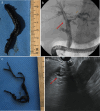Endoscopic Features of Post-COVID-19 Cholangiopathy and Its Management Using ERCP
- PMID: 37843039
- PMCID: PMC10984637
- DOI: 10.14309/ajg.0000000000002562
Endoscopic Features of Post-COVID-19 Cholangiopathy and Its Management Using ERCP
Abstract
Introduction: Despite growing awareness of post-coronavirus disease 2019 (COVID-19) cholangiopathy as one of the most serious long-term gastrointestinal consequences of COVID-19, the endoscopic features of this disease are still poorly characterized. This study aimed to more precisely define its endoscopic features and to outline the role of endoscopic retrograde cholangiopancreatography (ERCP) in the management of this entity.
Methods: In this observational study, 46 patients with confirmed post-COVID-19 cholangiopathy were included.
Results: Based on the endoscopic features observed in 141 ERCP procedures, post-COVID-19 cholangiopathy can be classified as a variant of secondary sclerosing cholangitis in critically ill patients. It appeared early in the course of intensive care treatment of patients with COVID-19 (cholestasis onset 4.5 days after intubation, median). This form of cholangiopathy was more destructive than stricturing in nature and caused irreversible damage to the bile ducts. A centripetal pattern of intrahepatic bile duct destruction, the phenomenon of vanishing bile ducts, the absence of extrahepatic involvement, and the presence of intraductal biliary casts (85% of patients) were typical cholangiographic features of post-COVID-19 cholangiopathy. This cholangiopathy was often complicated by small peribiliary liver abscesses with isolation of Enterococcus faecium and Candida spp. in bile culture. The prognosis was dismal, with a 1-year liver transplantation-free survival rate of 44%. In particular, patients with peribiliary liver abscesses or destruction of the central bile ducts tended to have a poor prognosis (n.s.). As shown by multivariate analysis, bilirubin levels (on intensive care unit day 25-36) negatively correlated with liver transplantation-free survival (hazard ratio 1.08, P < 0.001). Interventional endoscopy with cast removal had a positive effect on cholestasis parameters (gamma-glutamyl transpeptidase, alkaline phosphatase, and bilirubin); approximately 60% of all individual values decreased.
Discussion: Gastrointestinal endoscopy makes an important contribution to the management of post-COVID-19 cholangiopathy. ERCP is not only of great diagnostic and prognostic value but also has therapeutic value and therefore remains indispensable.
Copyright © 2023 The Author(s). Published by Wolters Kluwer Health, Inc. on behalf of The American College of Gastroenterology.
Conflict of interest statement
Figures








References
-
- Roth NC, Kim A, Vitkovski T, et al. Post-COVID-19 cholangiopathy: A novel entity. Am J Gastroenterol 2021;116(5):1077–82. - PubMed
Publication types
MeSH terms
Substances
LinkOut - more resources
Full Text Sources
Other Literature Sources
Medical
Research Materials
Miscellaneous

